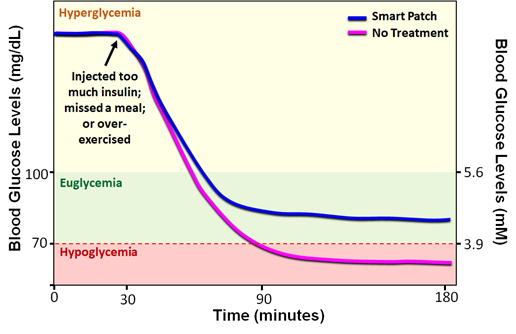Proof-of-Concept for Hypoglycemia Prevention

Hypoglycemia, or low blood sugar, can have serious effects, and it is, for most people with type 1 diabetes (T1D), the most feared complication of this disease. Even before it leads to a coma or seizures, hypoglycemia can carry with it sweatiness (like a panic attack), shaky hands, feeling weak and confusion. Typically, one would take a simple carbohydrate—be it juice, candy or a glucose tablet—to bring the blood sugar back to normal range. In extreme cases, people take rescue injections of glucagon, a hormone that raises blood sugar, but this is a difficult procedure and even more difficult for those that are unaware of hypoglycemia or require caregiver’s help. Hypoglycemia, therefore, is often a vicious cycle that often lasts for hours to a full day of intense, yet variable, glucose levels, for blood sugar to be normalized.
Prevention, therefore, is much better than rescuing from hypoglycemia, but there is nothing to prevent hypoglycemia occurrence. That makes hypoglycemia prevention a major unmet need in T1D management.
JDRF-funded Shirley X.Y. Wu, Ph.D., at the University of Toronto, is an expert in material sciences and “smart” drug delivery systems, and has been working on a prevention tool for hypoglycemia: a patch, applied to the skin, which will be able to tell if blood sugar is getting low and deliver glucagon at the right time, preventing hypoglycemia altogether. And in Advanced Materials, she provides proof-of-concept that it works.
In an animal model, the team showed that when blood glucose levels start to fall, glucagon is released from the patch into the bloodstream, preventing hypoglycemia. Those that had a control patch, without glucagon, experienced hypoglycemia.
“The development of hypoglycemia prevention therapies, such as this glucose-responsive glucagon patch, will be critical for people with type 1 diabetes,” says Jonathan Rosen, Ph.D., scientist at JDRF. “In addition to preventing hypoglycemia, a dangerous acute complication of diabetes, we expect it will reduce the daily burden of disease management by automatically handling blood-sugar lows.”
It’s a while before it goes to clinical trials in people, but the glucose-responsive glucagon patch has tremendous potential to prevent hypoglycemia, alleviate the psychological burden of anxiety over hypoglycemia and improve the quality of life for people with T1D.
“With the generous support from JDRF, our team will continue advancing the development of the glucose-responsive glucagon patch, aiming at clinical trials in the near future,” says Dr. Wu.
Find out more about how we’re turning type 1 into type none here.